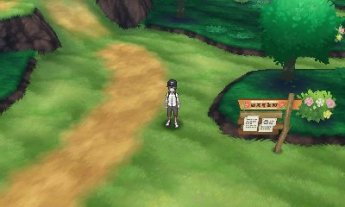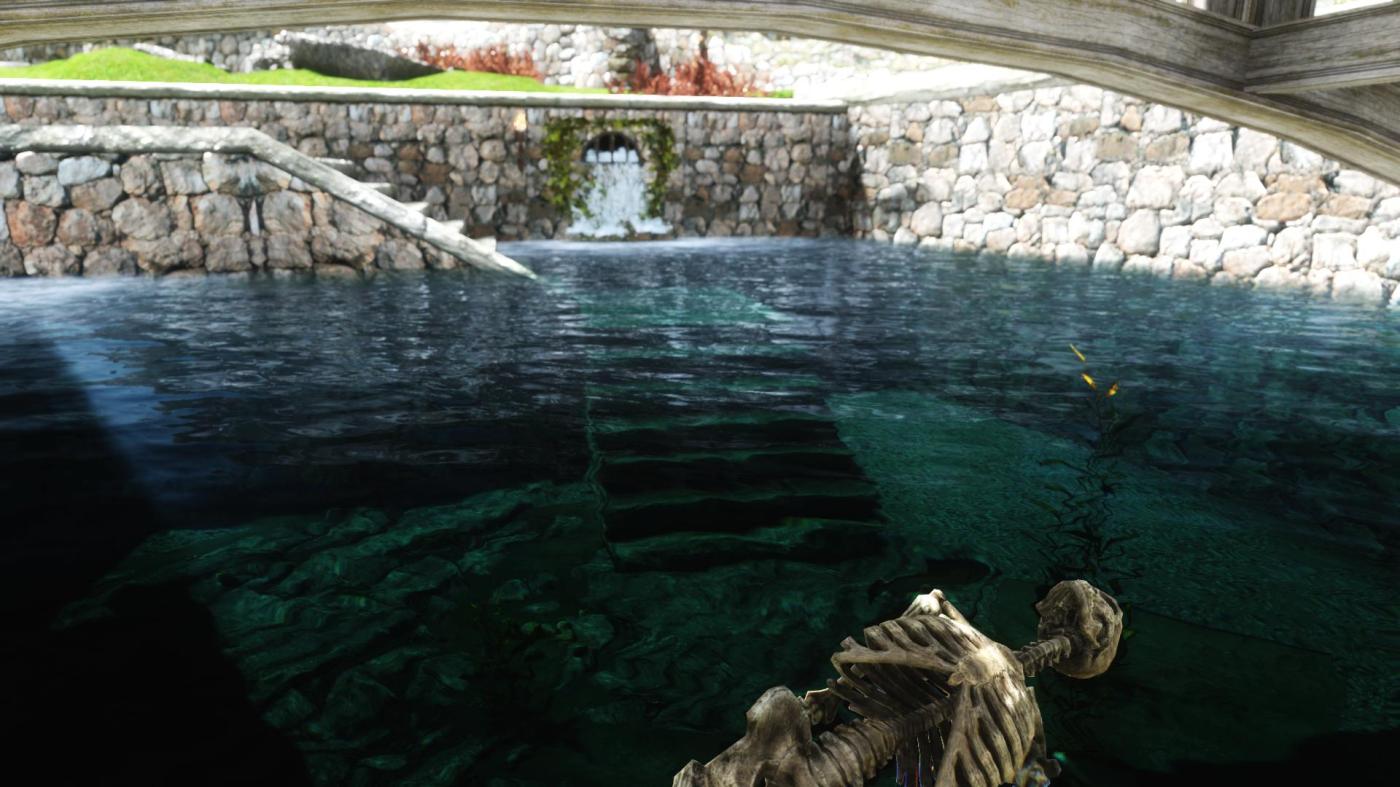You are walking down the darkened forest path, sunlight peeking through the canopy of leaves in a mottled pattern upon the ground. Your sword is drawn in your right hand – in your left you keep a healing potion at the ready. You move cautiously, scanning left and right as you go. Who knows what could be ahead? 
You come upon a small clearing, and see a broken carriage on the ground. The carriage is empty, and there is nothing around but a single skeleton – the unlucky driver you presume. What could have happened here? Bandits, you presume. But judging by the state of the remains, it is unlikely they are still around. This must have happened quite a while ago, and if the bandits were still around they most likely would have tried to hide the evidence of their presence.
You inspect the body, in the off-chance that the bandits left something behind. All you find is a single handwritten note. It was written by the woman this man will never return to, begging him not to leave her again.
The above tale is an example of environmental storytelling – a method of telling a story within a story through details in the environment. Environmental storytelling is a technique that has been used to great effect in games ranging from the Fallout games to the Five Nights and Freddy’s series, and serves a number of purposes. When done correctly, environmental storytelling can help flesh out the world of the game, increase immersion, and promote player engagement both within and outside of the game.
There Must be Something in the Water
Some games don’t even try to immerse players in their worlds. This is one of my biggest issues with games like Kingdom Hearts and Pokemon – while I enjoy both series, the worlds never really felt real to me. The paths were too constrained, with no room to explore, and aside from a few characters all the NPCs simply felt like robots designed to sell me loot or give me EXP.

On the other hand, a game like Skyrim makes the players feel like they are exploring a living, breathing world. Even though the inhabitants still behaved robotically much of the time, the world itself feels much more real, and it is easy to become immersed and invested in what happens to the world around you.
If you are trying to create a world that feels real, it is important that every detail placed into that world makes sense in context. For example, no matter how large and expansive your world there will inevitably be an edge that your player should not be able to cross. Some games might just put up an invisible wall, or make some arbitrary obstacle to block your way. However, these techniques can break the immersion in your game, and leave the player wondering why their character can’t just hop over the fence or go around the shrub blocking their way.
An immersive game, on the other hand, will create barriers that make sense within the world, to the point that players will never even question why they can’t get past an obstacle. Perhaps your world is surrounded by water, and the player can only swim for a certain length of time before drowning. Or maybe your player can’t climb or has limited climbing abilities – a high wall or mountain (in a place that makes sense) would be a natural barrier.
Environmental storytelling is an extension of this principle. Not only should the environment not break your immersion in the world, but it can actually deepen that sense of realism. Environmental details can help expand the lore of the world, provide information about the daily lives of it’s inhabitants, flesh out relationships and story points beyond what is required to progress the game, and so much more.
Reading the Atmosphere
Environmental storytelling is not really a single thing, but a wide category of techniques. There are a nearly endless number of ways of using environmental cues to expand the world and story of your game. In this section I hope to outline a few common techniques, with examples from various games.
Staging Scenes
This is the technique that I used in my opening paragraph, and is a very common technique for environmental storytelling. Using this technique, the designers will simply create a static scene that, when examined closely, can tell a story. This can be done through the setting of the scene (is the scene in the parlor of a fancy mansion, or an abandoned mental asylum?), the placement of props (why are those toilet plungers on the ceiling?), and the arrangement of people / creatures around the scene.
An example of this is the skeleton under the bridge from Skyrim (shown in the header image if you are reading this on WordPress). This skeleton can be found floating underneath the bridge in Whiterun, and there is really no explanation for who it is or how it got there. However, even this simple scene can get people’s gears turning, trying to come up with explanations and looking for clues about the identity of the skeleton. When combined with other techniques from this list, much more complex stories can be told.
Optional Reading
The written word has been used to tell stories for thousands of years, but sometimes your players just want to get through the game without being bogged down by thousands of lines of text. One way to get around this is to make the text optional – accessible to players who want it, but easily ignored by those who couldn’t care less.
There are many ways that this technique can be implemented. For a medieval or fantasy inspired world, perhaps you could place books, letters and scrolls around the world that provide further backstory and lore about the world and its characters. For a more modern approach, games like Fallout 4 and Watch_Dogs allow players to read emails off of computers, which can similarly allow players to learn more about the characters and plot in an unobtrusive way. 
A good example of this can be found in Fallout 4 – the story of D.B. Technical High School. By reading the terminal entries from computers scattered around the school, the player can slowly piece together the story of a bandit leader that has been inhabiting the school. The bandit leader gets bitten by a rabid dog and slowly goes insane from the disease. He begins terrorizing his own crew, and eventually begins to kill his own underlings. He later dons a bear mask (from the school’s mascot costume), and becomes known as “the beast” among the raider gangs, who become too afraid to even go near the basement where “the beast” lurks.
Items and Architecture
One of the subtlest ways to convey information about the world of your games is through the items / building that are used to populate it. For example, the craftsmanship of a weapon can do a lot towards explaining who forged it, and perhaps even when. By examining the architecture of a town, maybe you can see the history of conquest by the differing architectural styles that can be found.
The design and types of items and buildings you find around the world can tell you a lot about the inhabitants as well. Common symbols and motifs can tell you about the culture of the world, materials used can tell you how technologically advanced the society is, and the design of homes can tell you about the lifestyles and economic status of the occupants.
 This technique can be further combined with the previous techniques to create an even more complete picture of the world. Want to know what type of person a particular character is? Check what types of items they carry in their inventories. Want to subtly provide background details about the legendary King Rogan IV? A short item description on the item “Rogan’s Blade” will do the trick nicely.
This technique can be further combined with the previous techniques to create an even more complete picture of the world. Want to know what type of person a particular character is? Check what types of items they carry in their inventories. Want to subtly provide background details about the legendary King Rogan IV? A short item description on the item “Rogan’s Blade” will do the trick nicely.
A great example of this technique is the Dark Souls series, in which the lore of the series is told almost entirely through item descriptions. An example of this is “Aldrich’s Ruby”, shown above. Aldrich, Devourer of Gods is a required boss in the game, but (like most bosses in this series), very little is actually known about them. The little backstory that is known can be gleaned from details such as item descriptions that mention the character, as well as the Boss’s location (which is actually a call-back to the first game). Through these details, players have been able to come up with theories and connections that might help explain this mysterious character.
And the Rest
The techniques I have covered here today are only a few of the many options that can be used for environmental storytelling, and It would be impossible for me to list all of them. However, a few more examples of potential techniques include:
- Clothing and appearance of NPCs
- What people wear can sometimes tell you a lot about who they are
- Background dialogue
- It is not uncommon to hear bits and pieces of conversations while walking around the world, especially is you are sneaky. These conversations can be used to flesh out character motivations and relationships
- Character Routines and actions
- Some games have set routines for various NPCs, and observing these routines can reveal some surprising secrets!
- Real-world connections
- A great way to make a game feel more immersive is to create ways that the game can seep into real life. Examples are allowing players to actually call the phone numbers found in the game, or making websites that mimic those that the characters visit.
Until Next Time!
That is all I have for this week. If you enjoyed this article, check out the rest of the blog and subscribe on Facebook, Twitter, or here on WordPress so you will always know when I post a new article. If you didn’t, let me know what I can do better in the comments down below. Next week is going to be extremely busy for me (I’m grading more research assignments), but I am planning on writing a new article – a game designer’s dictionary. If you have ideas for terms that you want to be included, please post your ideas in the comments below. See you next week!


I really dig environmental story telling and you’ve done a great job of explaining it here.
Nice work with this piece.
LikeLike